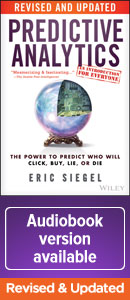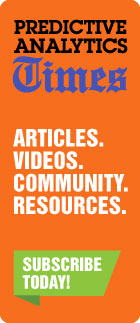Conference Day 1: Tuesday, March 31, 2015
Registration & Networking Breakfast
9:00-9:05am • Room: Nob Hill AB
Conference Chair Welcome
9:05-10:05am • Room: Nob Hill AB
Keynote
The Three Measures of Highly Effective Workforce Analytics Projects
Predictive workforce projects aim to identify workforce patterns and act on them to improve the business. In many cases predictions can be applied to individuals even before hiring a candidate.
In this discussion we present 3 essential metrics that should underlie every predictive workforce assignment. They define how the project's new insights will drive profit, loss, and ROI – the only metrics that will keep the business funding your analytics projects:
- What is the dollar cost of an employee in a specific role? Not just salary, but the full spectrum of an employee lifecycle.
- What is the dollar benefit of an employee to the company? How do these contributions change over time?
- How long do employees last in a role? What is the attrition rate at a range of tenure points?
Dashboard-worthy concepts such as Lifetime Employee Value are direct calculations from these three factors. We will show methods to leverage and combine these metrics, bridging workforce analytics outcomes into tangible business value.
In this discussion you'll learn to build this important baseline, make executives take notice, and win ongoing funding for your analytics projects.
[ Top of this page ] [ Agenda overview ]
10:00-10:30am • Room: Salon 8/9
Exhibits & Morning Coffee Break
10:30-11:15am • Room: Nob Hill AB
Track 1:
Case Study: Dignity Health
How Dignity Health is Using Analytics to Turn Employee Surveys into Real Business Drivers
Conducting an annual employee survey and measuring some form of engagement has become commonplace for many organizations. Unfortunately, advanced analytics show that employee engagement is NOT a driver of business outcomes (nor is engagement an actual business outcome). Dignity Health understood this and wanted to use their employee survey (and advanced analytics) to understand the specific aspects of their work environment that have the biggest direct impact on real healthcare business outcomes—and get this actionable information into the hands of every leader at every level in their organization. This presentation will show you how to integrate the most advanced analytics and business outcome data into the employee survey process and how to make the results simple and actionable for all leaders.
10:30-11:15am • Room: Nob Hill CD
Track 2:
Case Study: U.S. Special Forces
Hiring and Selecting Special Forces Personnel Using Predictive Analytics
Hiring and selection of personnel in specialized work environments incurs huge direct and opportunity costs for organizations. One of the largest challenges is that the selection process is often left in the hands of those with either high experience in the domain area but little experience in selection or vice versa.
Predictive Analytics and statistics can play a critical role in formalizing and automating much of the selection process. This session provides an overview of the selection processes using both skills and psychological measures to quantify IQ, domain knowledge, grit, and determination. Examples will be drawn from marketing practices for U.S. Special Forces using predictive analytics teams to rank prospective candidates.
[ Top of this page ] [ Agenda overview ]
11:20am-12:05pm • Room: Nob Hill AB
Track 1:
Prescriptive Analytics for People and Things
For decades different technologies and techniques have been serving two disjoint worlds: the realm of People and operations for assets, now evolved into the Internet of Things (IoT). In present day, operational excellence pressure, combined with the availability of unprecedented data and processing power, has led innovative companies to take a comprehensive approach, covering both People and Things. Several actual case studies will contrast the benefits of different approaches over time, focusing on the how and why.
In this session, attendees will learn:
- The evolution of approaches over the years
- The benefits achieved by companies that have embraced prescriptive analytics
- The lessons learned on such initiatives
11:20am-12:05pm • Room: Nob Hill CD
Track 2:
Case Study: ASB
How American Savings Bank Uses a Predictive Analytics Approach to Reduce Teller Attrition
ASB is one of Hawaii's largest financial institutions with a strong "aloha" spirit and commitment to serving customers and employees alike. They are the recipient of one of Hawaii's "Best Places to Work" award five years in a row and have been selected by American Banker Magazine as one the "Best Banks to Work for" in America. Facing a common challenge with Teller attrition, ASB opted to take a predictive analytics approach to understand and solve this perplexing challenge.
This discussion will review this project from both a business and operations point of view and will discuss what is it like to thrive during a large Data Science exercise to reduce attrition.
[ Top of this page ] [ Agenda overview ]
12:05–1:30pm • Room: Salon 8/9
Lunch in the Exhibit Hall
 12:05–1:30pm • Room: Nob Hill CD
12:05–1:30pm • Room: Nob Hill CD
Lunch and Learn
How to Leverage Predictive Analytics to Reduce Attrition Rates
Employee turnover is an expensive problem and the costs and time associated with finding qualified replacements add up quickly. Even worse, most of the time the HR team only finds out after an employee has decided to leave. True, it is not always avoidable, but wouldn't it be great if you could proactively identify employees at risk of attrition before they left? And even better if you knew what actions to take to keep them? This workshop will walk you through how to prepare for and deploy a proven predictive analytics methodology that will reduce turnover. In this session you will learn:
- How to use your HR data to identify employees at risk of attrition
- How to predictively enable managers with employee specific actions to retain key employees
- Full range of benefits that can be achieved with predictive analytics for retention
- Other applications for predictive analytics in HR
1:30-2:15pm • Room: Nob Hill AB
Keynote
Why the Rapidly Changing World of Analytics Matters for both HR and Business.
In this important Keynote presentation, Holger will discuss how the latest analytics trends (i.e. using multiple models to predict outcomes) are transforming today's workforces and the businesses they power.
Keynote attendees will learn:
- How predictive analytics has changed over the years
- Why this matters to employers and their workforces everywhere
- How some analytics approaches are seen, evaluated and used in HR departments and beyond.
- Thought provoking workforce and business analytics predictions
2:15-3:05pm • Room: Nob Hill AB
Many Paths to Performance: Visualizing and Predicting How Workers Succeed or Fail
In the search for quality sales representatives, it is tempting to think there is only one successful "type" of rep. In fact, this study suggests there are multiple pathways of sales achievement.
Using big data technologies, we analyzed millions of sales records for thousands of national sales reps. Our analysis revealed several well-travelled pathways to sales success. Some hit the ground running, some were gradual learners who eventually excelled, some gamed the system to win and many others failed.
What can we learn, infer, and predict from these patterns? Hiring, cost, operations, and predictive implications directly follow from using an analytics approach to understand these paths. Participants should expect to learn about the sales analysis that identifies multiple pathways to sales achievement.
3:10-3:30pm • Room: Nob Hill AB
Track 1:Predicting and Reducing Burnout Among Road Warriors
Too much travel causes turnover among road warriors. Since road warriors are some of a company's most valuable employees, firms need a way to reduce the attrition rate in this workforce segment. This session describes a pioneering approach to predicting which travelers are at the greatest risk of quitting.
The session covers these key steps: Classifying road warriors using normalized travel data, applying a statistical model to estimate who has quit, comparing estimates to actual quits, and forecasting the attrition risk factor to the remaining frequent travelers.
The final result is a predictive traveler turnover model, combined with an array of options for intervening and mitigating the attrition risk of these key employees.
3:10-3:30pm • Room: Nob Hill CD
Track 2:
Applying Predictive Analytics to Improve Talent Retention
For years, data has been used in sales and marketing functions to measure current and past results and even predict future events. But this same use of data has not always transferred to how organizations recruit, develop, and retain their employees. In this session, you will hear about how advanced analytics can be used to identify and predict important HR outcomes, which ultimately leads to taking the correct action on the correct employees.
Exhibits & Afternoon Break
4:05-4:25pm • Room: Nob Hill AB
Track 1:
Case Study: VoloMetrix
People Analytics: Maximizing your "Return on Workforce"
We hear the phrase that people are the company's most valuable assets all the time, but most companies have a difficult time properly valuing their human capital investment. In fact, most employees are treated as an overhead expense instead of assets that have future value.
The classic business calculation of Return on Investment, or ROI, is the most common profitability tool to gauge value. What if we were to look at our workforce like an investment and began to nurture and cultivate a method to achieve improved workforce performance?
We call this new viewpoint RoW or Return on Workforce. These techniques now allow you to improve organizational efficiency, sales productivity and the engagement of employees.
4:05-4:50pm • Room: Nob Hill CD
Track 2:The Power (and Peril) of Predictive Analytics
Learning from data is extremely powerful and its use is transforming business decision-making in multiple industries at an accelerating pace - saving money and even lives. It's an exciting time to be a Data Miner! To be excellent at the work, we need to listen well - to transform a real-world challenge into a close, but solvable problem; we need to be expert in key technological methods, and we need to be keenly aware of our weaknesses in making judgments - including cognitive biases (for us humans) and lack of any sense (for our computer allies). I will share stories of warning and of encouragement, from a life in the field.
4:30-4:50pm • Room: Nob Hill AB
Track 1:Case Study: Predixion Software
Retaining top talent with Predictive Analytics
All organizations feel the pain of employee attrition. Replacing high performing employees is a costly proposition that includes productivity losses, training costs, recruiting fees and decreased morale. Learn how one organization has leveraged their employee data to predict which employees are about to leave and automatically recommend actions to prevent turnover, which will ultimately lead to increased productivity, improved employee morale, and a reduction in costs associated with attrition.
4:55-5:40pm • Room: Nob Hill AB
Track 1:
Using Predictive Analytics to Create a Leadership Index
Classically all Leadership assessment is done with surveys: Self-Assessment, Pier Review, and Organizational Census. This process is reactive, causes less frequent feedback, and prone to survey fatigue if over leveraged. This talk will explore a multivariate and proactive method for examining the "Digital Fingerprints of Leadership" and prescribing action in places where Risk is present and the collaboration between boss and subordinate are breaking down. I'll present a new perspective on quantifying Leadership- a method of reimagining employee engagement, but without surveys. Through the usage of readily available surrogate metrics you can target areas where communication, respect, and trust are dividing. Once identified, HR resources can be deployed, action plans can be created, and progress can be measured. Imagine being able augment the once-a-year organization engagement survey? Many forward thinking companies have already realized that this snapshot in time approach to measuring the passion of their workforce is outdated and doesn't suit their needs. The concept of leveraging existing real-time data opens the door for significant improvements to dynamically measuring action plans, retention efforts and overall business performance.
4:55-5:40pm • Room: Nob Hill CD
Track 2:
Case Study: ABM
How ABM-Mercer Used Predictive Analytics to Optimize ABM's Workforce
ABM, a leading provider of facility solutions, sought to understand whether it could manage its workforce more consistently across its divisions, to drive value for its clients and improve profitability. To assess the potential of such changes, ABM teamed with human capital experts at Mercer to statistically model the running record of business performance across a sample of its US operations to assess optimal workforce practices.
This analysis, which linked unit profitability to workforce characteristics and management, pointed to significant efficiencies in scaling managerial authority, improving workforce flexibility, and greater consistency in management of employees across its divisions supporting no less than wholesale changes in the business's structure and its go-to-market proposition.
Networking Reception
Conference Day 2: April 1, 2015
Registration
8:00-9:00am • Room: Grand Assembly
Networking Breakfast
9:00-9:05am • Room: Nob Hill AB
Conference Chair Welcome Remarks
8:50-9:40am • Room: Nob Hill AB
Keynote
How Walmart's Predictive Analytics Models Improve
Associate Experience and Performance
Walmart, just like most smart retailers understand the value of human capital – the 2.2 million associates around the globe. To maximize the value we get, we often rely on science to ensure we optimize the work environment and understand what's on our associates' mind. Predictive models help us quantify trends beyond one store or one market and address those trends all with the goal to make the work place better for our associates. Walmart's turnover rate is below the retail industry average. In fact over 45 percent of our workforce has been with Walmart for over 5 years and over 60 percent has been with us at least 2 years. Among other things, we will discuss in more detail how one of our models helps us stay best in class when it comes to retention and how our associate engagement remains at industry high levels.
[ Top of this page ] [ Agenda overview ]
10:00-10:20am • Room: Nob Hill AB
Track 1:Case Study: Cisco
Integrating Predictive Models within a Rules Engine for Resource Allocation
Cisco successfully integrated predictive models with our business rule engine to match individual support cases to in-house engineers. We quickly discovered that handling cultural behaviors and balancing between global consistency and regional flexibility were just as important as the accuracy of a model. The secret was not to force black and white tradeoffs between humans and predictive models. A more optimized answer is available when you blend the two. This session will demonstrate how we divided the decision space into two areas: one where models perform well and another where strategy and situational awareness are more easily captured and leveraged, and then how we resolve the decision.
10:00-10:45am • Room: Nob Hill CD
Track 2:
Case Study: AOL
How AOL is Using Predictive Analytics as a Strategic HR Solution
Predictive analytics provides a significant opportunity to transform how companies find and retain the talented people that make their businesses successful. Navigating this transformation requires a unique blend of data, strategy, communications and analytical talent.
John will discuss how AOL's People Analytics team is engaging with business leaders, prioritizing projects and changing the conversation about people data from being limited to past and current operations to focusing on future strategic wins. He will also present an example of a recent analytics project that has already changed the way that AOL engages with its employees.
10:25-10:45am • Room: Nob Hill AB
Track 1:
Case Study: Oracle
Pre-Built Predictive Analytics Applications: Anticipating Employee Voluntary Turnover and Predicting Performance
Human Resources can deliver strategic value to their organizations by performing predictive analytics on the HR data that is managed within their Human Capital Management applications. Oracle Fusion HCM Predictive Workforce module delivers pre-built predictive analytics methodologies that identify both employees who are likely to voluntarily leave the organization and why and future top performers. This information can help you anticipate and prevent employee turnover of your key employees. By integrating predictive analytics methodologies deep inside operational enterprise applications, HR can help managers even perform "What if?" analysis prior to managerial decisions to retain top employees. The current HR reactive approach simply does not work, which is proven by the fact that companies spend less than one percent on an area that costs them 31 percent. In order for HR to be successful, it must embrace the shift towards predictive analytics and leverage their employee and applicant data for competitive gain.
[ Top of this page ] [ Agenda overview ]
10:45-11:15am • Room: Salon 8/9
Exhibits & Morning Coffee Break
11:15am–12:00pm • Room: Nob Hill AB
Track 1:
ABN-AMRO’s 2-year Journey with HR Predictive Analytics
As a member of the HR management team of ABN-AMRO bank in the Netherlands, Patrick Coolen – Manager Workforce Planning & HR Analytics - initiated a small research project in 2012 where he applied statistics to the HR data in order to retrieve better information to support HR decision-making. Because of the success of this project ABN-AMRO decided to set up a specific department for HR analytics and strategic workforce planning. Patrick is heading this department and partners with iNostix, a niche European predictive workforce consultancy, for all the analyses. Patrick and Luk will present details on several specific ABN-AMRO analytical projects, the analytical approach that was used and the lessons learned from the past 2 years.
11:15am–12:00pm • Room: Nob Hill CD
Track 2:Stories from the Front: Practical Adoption Challenges to Predictive Analytics
This presentation will examine the readiness of various clients and former employers to be able to consume analytics, benchmarks and predictive models. Use cases examined will provide context for 5 key ways we can ready ourselves for various insights.
[ Top of this page ] [ Agenda overview ]
12:00–1:30pm • Room: Salon 8/9
Lunch in the Exhibit Hall
1:30–2:15pm • Room: Nob Hill AB
Track 1:
How Well Can Publicly Available Data Predict Who Will Leave Your Firm? Very Well
Never has there been more public data available regarding a firm's employees. Recruiters increasingly use it to pull passive job seekers out of your company. But what if you could predict who was at highest risk of being poached? We will demonstrate how publicly available data compares and contrasts with internal data. hiQ Labs will also discuss the business case and ethics of using public data to help firms protect their most valuable asset.
1:30–2:15pm • Room: Nob Hill CD
 Track 2:
Track 2:
Predictive Analytics – What's Next in 2015?
The topic of "big data" continues to dominate 2015 strategy discussions in C-suites across every industry and geography. One of the greatest areas of opportunity is in the Human Resources function; the potential to gain greater understanding and perhaps even predict actions and outcomes of the workforce excites every CEO and Board. But exactly how does an organization move from a qualitative and reactive management of its workforce to a more quantitative, evidence-based management of its workforce? What value will be created, what decisions will be made and what does the future hold in as we enter the dawn of the predictive analytics revolution? Please join Gene Pease, Founder and CEO, and Brian Kelly, President, of Vestrics as they discuss why leading organizations across the globe are rapidly developing predictive analytics capabilities within the HR function. This highly engaging session will focus on answering such key questions as:
- What is predictive analytics?
- How do organizations get started?
- What type of documented case studies exist?
- What skills, capabilities and resources are required?
- What are the required frameworks for success?
The 45 minute session will be followed by 15 minutes of Q&A with two innovative industry thought leaders of the predictive analytics industry.
2:15–3:00pm • Room: Nob Hill AB
Expert Panel
Attrition, Retention and Flight Risk (Oh My). Success Stories from Predictive Workforce Leaders
One major challenge impacting many organizations is employee churn (attrition). Though we all know it is expensive, few know that it is controllable. This panel of Predictive Workforce Leaders will share key benefits and tangible outcomes from calculating flight risk and provide the impetus for proactively tackling this issue directly in 2015.
Moderator:Panelists:
Exhibits & Afternoon Break
3:30–4:15pm • Room: Nob Hill AB
Track 1:
Leveraging Predictive Analytics to Optimize Your Talent Lifecycle in the Big Data Era
Monster was the pioneer in the online recruitment industry; the first job board and first public resume database in the world.
To maintain its competitive advantage it has taken a data-driven and innovation road using research, big data solutions, predictive analytics and artificial intelligence to deliver the best experience and great value to its employers and job candidates.
Join this session to hear how in today's competitive labor marketplace and changing workforce you can optimize your employee lifecycle by injecting advanced analytics at every stage of your talent lifecycle.
JP Isson will also discuss how people analytics in propelled by predictive analytics will change the way you attract, acquire, develop, promote and retain talent.
 Jean-Paul Isson
Jean-Paul IssonAuthor, International Speaker, Global Vice President BI & Predictive Analytics
Monster Worldwide
3:30–4:15pm • Room: Nob Hill CD
Track 2:
Human Analytics at Starbucks, RE/MAX, Capital One, Micron and other Fortune 500 Companies
This presentation shares the results of human analytics projects for various fortune 500 companies with the aim to demonstrate:
- customized methodologies deliver solutions that are specific to the culture of the company and
- how analytics can be a powerful tool in identifying a wide range of levers, not just those that have been traditionally used in the past. For example, the protocol used to collect employee responses at Starbucks was designed from employee focus groups rather than by the consultants. This results in findings that would not have been identified if employees were not involved in the development of the protocol. Also, customized human analytics studies can identify solutions that transcend a given department. At Capital One for example, employee responses to various surveys were analyzed to identify certain responses that were powerful in improving business performance in many ways, not just the traditional performance measures.
[ Top of this page ] [ Agenda overview ]
4:15-5:00pm • Room: Nob Hill AB
Track 1:
Names and Numbers: Leveraging HR Culture to Accelerate the Adoption of Workforce Analytics
Human Resources professionals have traditionally managed their company's workforce via intuition, experience and interpersonal talent, not by data analysis. Analytics professionals, on the other hand, are typically most comfortable building data-driven solutions, though they may lack the organizational acumen to achieve the consensus necessary for implementing their work. Such diametric framing presents a false model of the distinction between HR and Analytics, it nevertheless captures a useful observation: cultural differences between HR organizations and Analytics teams that may impede the success of nascent Workforce Analytics endeavors instead can be used to accelerate the implementation of data-driven workforce planning.
This presentation will share what I have learned about navigating and leveraging these cultural differences to accelerate the organizational adoption of Workforce Analytics. In addition, I will discuss why fostering the company-wide development of analytics talent should be a long-term imperative for all Workforce Analytics teams and how to harness HR's strengths to further this objective.
4:15–5:00pm • Room: Nob Hill CD
Track 2:
Case Study: Predictive Execution Analytics
Driving High Performance Business Outcomes Through Predictive Team Analytics
In today's business environment extreme collaboration has become the vehicle to solve complex business challenges and outcomes. Predictive Execution Analytics (PEA) is a new research based effort to understand this inflection and predict/drive the outcomes of teams up to 12 months out.
We will focus on 3 things during the presentation:
-
a) What are PEA and their research foundation
b) Client examples
c) Describe why PEA are critical to connecting HR interventions to business outcomes and PEA in action.
[ Top of this page ] [ Agenda overview ]





























































